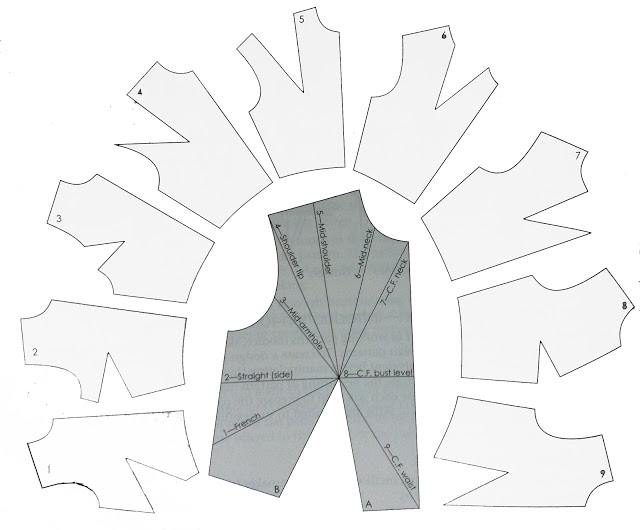So... what is a dart? A dart is simply a fold sewn into fabric to help provide a three-dimensional or structured shape to a garment (where the body has extreme contours such as the bust, hips, elbow, etc). They are frequently used in clothing to tailor the garment to the wearer's shape. They confine unneeded fullness at the pattern's edge. They can have one or two pointed ends, depending on style. Some people mark in the centre line of the dart, which just indicates the fold line.
Dart manipulation is the most basic and the most useful skill the pattern cutter uses. Basically, if you can get your head around this... you're laughing!!! Your design options will be endless!
Each part of the basic block has darts, which can be moved to create various numbers of styles. A dart can be transferred to any location around the pattern's outline from a designated pivotal point without affecting the size or fit of the garment.

Dart locations
These are the most common areas for dart relocation and for creating design patterns. However, they aren't the only dart locations because a dart can be transferred anywhere around the pattern's outline.
*The french dart (1) can be placed at any angle below the straight dart (2).
*The CF (center front) bust dart (8) and straight dart (2) are squared from the center front.
*The mid armhole dart (3) is directed from bust points to the armhole notch
*The shoulder dart (5) is usually placed at the princess line.
Note***
When manipulating darts on the bodice front, wherever the darts are situated, they should converge at the bust point but in practise darts are NOT generally sewn to this point as it is considered unflattering. On completion of the dart movement, redraw the new dart by shortening it (aprox 1.5cm - 2cm, depending on style) from the bust point (shown in red). For you novices, BP is an abbreviation for Bust Point.

1. SLASHING (for a more detailed explanation with examples, click here).
* Slashing is the more creative method and can be used for all styles.* It can be more time
consuming than pivoting but it is a more controllable method. * It is suitable for the less
experienced pattern cutter.
2. PIVOTING (for a more detailed explanation with examples, click here).
* Pivoting is often the quicker and cleaner method, but cannot be used for all styles.
* When pivoting, it's important to remember that the CF (center front) and CB (center back)
should remain on the grain (unless moving darts into these positions).

Direction of dart excess
Follow the arrows below for direction of the dart excess when folded. The excess is placed on the back side of the pattern and on the wrong side of the garment.
Excess fold downwards for darts located anywhere along the
* armhole
* side seams
* center lines
Excess folds towards the center front or center back for darts located anywhere along the
* shoulder
* neckline
* waistline
Note***
The folded dart follows the shape of the seam it lays against otherwise it will twist when stitched.

2. PIVOTING (for a more detailed explanation with examples, click here).
* Pivoting is often the quicker and cleaner method, but cannot be used for all styles.
* When pivoting, it's important to remember that the CF (center front) and CB (center back)
should remain on the grain (unless moving darts into these positions).

Direction of dart excess
Follow the arrows below for direction of the dart excess when folded. The excess is placed on the back side of the pattern and on the wrong side of the garment.
Excess fold downwards for darts located anywhere along the
* armhole
* side seams
* center lines
Excess folds towards the center front or center back for darts located anywhere along the
* shoulder
* neckline
* waistline
Note***
The folded dart follows the shape of the seam it lays against otherwise it will twist when stitched.




This comment has been removed by the author.
ReplyDeleteTanhks! very useful
ReplyDeletePls tell me the standard width of waist darts, Tq.
ReplyDelete